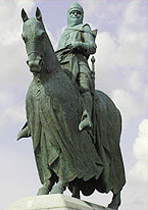Family of Bruce People
 Robert the Bruce 1274-1329
Robert the Bruce 1274-1329
Robert Bruce of Annadale had two sons, Robert and Edward. Although his father was pro-English to protect his wealth, Robert junior had moved to back Wallace and independence for a time, telling his father, “I must be with my own”, but only until 1302 however when he made a truce with Edward.
The Bruces had been within reach of the Scottish crown for a third generation competing for it against other family claims from the Balliols, Comyns, Frasers and others. For years he juggled his various interests and sat on Edward’s “Scottish Council”
When he stabbed John Comyn to death in a church in 1306 he had not only made himself an enemy of the mighty Comyns, but committed sacrilege, invoking instant excommunication by the church. He moved for open rebellion against Edward and his supporters, crowning himself King of Scots at Scone.
Despite widespread support, an English army under Aymer de Valence stopped the rebellion in its tracks at Methven on 26th June. Once the richest man in the country, Bruce was hiding in caves. His allies and family were rounded up an executed; Simon Fraser’s head was made spiked company for William Wallace’s on London Bridge
Yet on Palm Sunday the following year, Bruce and his remaining support began a guerrilla war which brought them success after success. The Black Douglas was emerging as England’s terror. Angus Og, who’s descendants would be the MacDonalds brought his forces from the Isles. The Earls of Atholl and Lennox came into the war against Edward, the Comyns and the MacDougalls.
By the summer of 1308 Bruce was in control of almost all of Scotland above the Forth and in March of 1309 Parliament was held in St Andrews.
Edward I was now dead, ordering his son to have his bones present in a bag at the front of the army that destroys Bruce. It was not until June 1314 that Edward II assembled his army to retake Scotland. When his highly equipped army, three times the size of Bruces reached Bannockburn Bruce was waiting for him.
Edward did not try again till 1322 when he found himself having to abandon his belongings and keep running till he reached Yorkshire. The Declaration of Arbroath was written in 1320 when the leaders of Scotland signed a letter to the Pope declaring their Scottish Independence and Robert I their King, and explaining that they would fight anyone who was against their freedom. In response Pope John Paul XXII annulled Robert’s excommunication.
In 1328 peace was sued for with Scotland. Bruce’s son David was married to Edward III’s sister though both were infants. The King died of leprosy the following year and the in-fighting and English coercion would soon begin again.
It was Bruces wish that his heart be taken to be buried in the Holy Land. His friend James Douglas died in the attempt while fighting the Moors in Spain. With his body buried in Dunfermline his heart came back to Melrose.
read more about Robert the Bruce and The House of Bruce >>
Thomas Bruce (1766-1841)
The seventh Earl of Elgin, the famous diplomat who devoted his own private fortune to reclaiming the ‘Elgin Marbles’, or the marbles of the pantheon that were decaying beyond repair.
Sir William Bruce (c1630-1710)
Architect responsible for the remodelling of Holyrood and Hopetoun House.
Quick Links to Clan Bruce Products from The Clan Shop
- Bruce Tartan Tie
- Bruce Tartan Pocket Square Handkerchief
- Bruce Tartan Scarves
- Bruce Tartan Kilts
- Bruce Clan Crest Badge
- Bruce Clan Crest Mug
- Bruce Clan Crest T-Shirts
- Bruce Clan Crest Belt Buckle
- Bruce Phone Covers
- Bruce Tartan
- Bruce Clan Crest Crystal Glasses
- Bruce Clan Crest Cufflinks
- Bruce Clan Crest Sgain Dubh
- Bruce Clan Crest Kilt Pin
- Bruce Clan Crest Plaques





